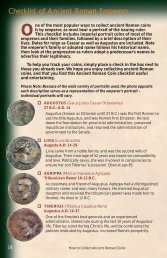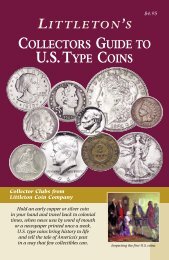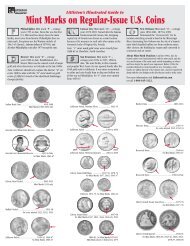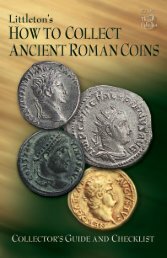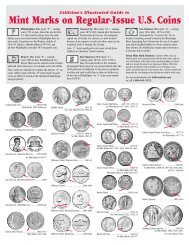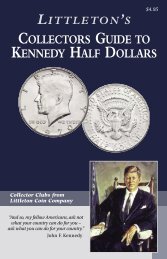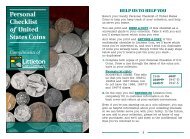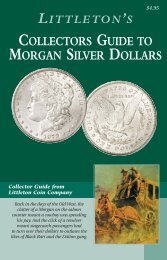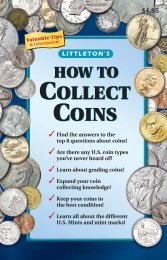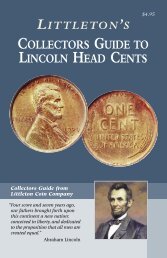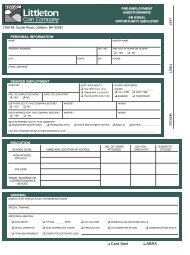Collectors Guide to Lincoln Head Cents - Littleton Coin Company
Collectors Guide to Lincoln Head Cents - Littleton Coin Company
Collectors Guide to Lincoln Head Cents - Littleton Coin Company
Create successful ePaper yourself
Turn your PDF publications into a flip-book with our unique Google optimized e-Paper software.
4The <strong>Lincoln</strong> Cent – Longest Lived andMost Popular <strong>Coin</strong> in U.S. His<strong>to</strong>ryFrom the day it first appeared in 1909, the <strong>Lincoln</strong> centhas been an extremely popular coin.Newspapers heralded the release of the newcoin and the public responded with unprecedentedexcitement. The coin represented a step in<strong>to</strong> themodern age for circulating U.S. coinage.The first coin <strong>to</strong> honor agreat American leaderFor more than a hundred years, the U.S. Minthad exclusively used female figures representingLiberty on circulating coins. The tradition wentback <strong>to</strong> George Washing<strong>to</strong>n’s wish not <strong>to</strong> havehis portrait on regular coins – Washing<strong>to</strong>n feltstrongly that it was <strong>to</strong>o much like thepractice of European monarchies, and thatthe use of allegorical figures was moreappropriate for a democracy.However, by the time of the 1909centennial of Abraham <strong>Lincoln</strong>’s birth, theidea of honoring an actual person had gainedacceptance and even enthusiasm. It helped thatPresident <strong>Lincoln</strong> was very much revered by the public. So, the <strong>Lincoln</strong> centbecame the first regular-issue U.S. coin <strong>to</strong> depict an actual person, and notan allegorical figure. This new design paved the way for the U.S. coinage thatwould follow later on in the century, with circulating coins dedicated <strong>to</strong> greatleaders of the United States.A prized collectibleright from the start!No one was prepared for the level of publicdemand for the <strong>Lincoln</strong> cent. Banks andbusinesses inundated the mint with requestsfor the new coins. Before distribution began,the mint struck over 25 million anticipatingthat this would be more than enough <strong>to</strong>meet the initial demand.When the cents finally were released<strong>to</strong> the public in August 1909, peopleformed long lines at banks andsub-treasury offices in their eagerness<strong>to</strong> get the new coins. And, even thoughthe distribution points limited thenumber available <strong>to</strong> each person, signssoon appeared <strong>to</strong> announce NO MORELINCOLN PENNIES.
6Escape <strong>to</strong> AmericaBefore the sentence could becarried out, Vic<strong>to</strong>ras fled <strong>to</strong>America with his brother andsister. He arrived in New YorkCity in 1890, and worked as adie-cutter in a fac<strong>to</strong>ry whilestudying art and design at night.He applied for citizenship underthe name Vic<strong>to</strong>r David Brenner.In 1894, Brenner opened a smallworkshop and produced medalsand plaques <strong>to</strong> finance furtherstudy of medallic art in Paris. He returned from France in 1906 as a highlyacclaimed medalist with more than 70 medals and plaquettes, and asuccessful international exhibition, <strong>to</strong> his credit.In 1908, he was asked <strong>to</strong> create a Panama Canal service medal portrayingPresident Theodore Roosevelt. When Roosevelt posed for the medal, Brennersuggested <strong>to</strong> him the idea of honoring Abraham <strong>Lincoln</strong> with a coin.Roosevelt was impressed by a <strong>Lincoln</strong> centennial plaque Brenner wasalready working on, and <strong>to</strong>ld Brenner <strong>to</strong> go ahead and design a <strong>Lincoln</strong> coin.A <strong>Lincoln</strong> Half Dollar?Brenner had in mind that the new <strong>Lincoln</strong> coin should bea half dollar. However, the direc<strong>to</strong>r of the mint informedhim that only the cent and the nickel were up for redesign– other denominations would take an act of Congress <strong>to</strong>change at that time. So, the cent became the coin <strong>to</strong>honor <strong>Lincoln</strong>.Brenner adapted the portrait for the cent’s obverse fromhis <strong>Lincoln</strong> plaque and medal. For the reverse, he chose asimple, yet bold inscription of ONE CENT, framed by twostylized ears of wheat.The no<strong>to</strong>rious initialsIt was normal for medals <strong>to</strong> be inscribed with the designer’sname, and Brenner signed his full name <strong>to</strong> the firstproofs, as he was accus<strong>to</strong>med <strong>to</strong> do. For U.S. coins atthe time, the designer’s single initial was used at thebase of Liberty’s neck – the Barber series all have a Bfor Charles Barber, and Morgan dollars, an M forGeorge Morgan. Mint officials informed Brennerof their policy and he was agreeable. But,Charles Barber, still chief engraver at themint, did not wish the public <strong>to</strong> think thathe, Barber, was responsible for the newdesign, so rather than a single B, all threeof Brenner’s initials V.D.B. were used andplaced on the reverse.
Brenner himself was far more concerned and adamant about the qualityof the <strong>Lincoln</strong> portrait than about how his credit should appear. However,upon the cent’s release, journalists ignorant of the initials already on otherU.S. coins, seized upon the V.D.B. as egotism on the designer’s part.Combined with putting an actual person on a U.S. coin, the initials wereregarded by some as “the first visible and outward emblem of thetransmogrification of the republic in<strong>to</strong> an empire” (New Orleans Picayune).The prominence of the V.D.B. was widely criticized in the media.V.D.B. removedSecretary of the Treasury Franklin MacVeagh suspended striking of <strong>Lincoln</strong>cents on August 5, 1909, after about 29 million had been struck with V.D.B.The intent was <strong>to</strong> replace the initials with an inconspicuously placed B, butBarber objected, arguing that it would take <strong>to</strong>o long <strong>to</strong> change the dies.However, he suggested, if the initials were simply removed al<strong>to</strong>gether, thischange could be quickly done <strong>to</strong> just the hubs, and production could beresumed within three days.With all the publicity surrounding the new cents,the revenue that would be lost by the productiondelay if the dies were changed, and probably insome part considering Chief Engraver Barber’spersonal jealousies, it was decided <strong>to</strong> just removethe initials al<strong>to</strong>gether.This change <strong>to</strong> the brand-new cents right aftertheir release received plenty of publicity, and thehoarding of the V.D.B. cents became widespread.For this reason, many V.D.B.s have survivedin higher grades. Other low-mintage earlyAfter 1918, Brenner’sissues were not as easily and immediatelyinitials were on therecognizable, so they were not set aside incent’s obverse.quantity the way V.D.B.s were.In 1918, after Barber’s death, V.D.B. was res<strong>to</strong>red <strong>to</strong> the cent, this time onthe obverse, and barely visible <strong>to</strong> the naked eye. Vic<strong>to</strong>r David Brenner’sdesign has s<strong>to</strong>od the test of time, and his <strong>Lincoln</strong> bust is one of the mostreproduced works of art in the world.Key dates and othercollec<strong>to</strong>r favorites fromthe early yearsThe first-year-of-issue 1909 and 1909-S V.D.B.cents are probably the best known of all the<strong>Lincoln</strong> cent varieties. The 1909-S V.D.B. alongwith the 1914-D are the two extremely lowmintage“key dates” of the series (the <strong>to</strong>ughestcoins <strong>to</strong> get). But there are many other fascinating<strong>Lincoln</strong> cent issues, which is one of the reasonsthese coins are so popular with collec<strong>to</strong>rs.Shown clockwise from <strong>to</strong>p right: 1911-D,1921-S, 1924-D, 1914-D, 1910-S7
Frank Gasparro, then an assistant engraver,FrankGasparro,submitted the winning design, which featured the designer of<strong>Lincoln</strong> Memorial. The <strong>Lincoln</strong> Memorial reverse Memorialhelped establish Gasparro as a talented engraver. ReverseHe became the chief engraver of the U.S. Mint in1965. Also <strong>to</strong> his credit are designs for the Eisenhowerdollar, the Anthony dollar, the Kennedy half dollar reverse,and collaboration on Bicentennial coinage.A monument <strong>to</strong> the 16th Presiden<strong>to</strong>f the United StatesThe <strong>Lincoln</strong> Memorial itself was first authorized by Congress in 1867, andwas intended <strong>to</strong> honor <strong>Lincoln</strong> two years after his assassination. However,the necessary funds weren’t appropriated until 1911. Ground was broken onFebruary 14, 1914 about a half-mile east of the Washing<strong>to</strong>n Monument inWashing<strong>to</strong>n, D.C. The Greek-style temple <strong>to</strong>ok seven years <strong>to</strong> complete, andwas officially presented <strong>to</strong> the American people on May 30, 1922.10<strong>Lincoln</strong> Memorial in Washing<strong>to</strong>n, D.C.The awe-inspiring structure features a Colorado marble exterior, Indianalimes<strong>to</strong>ne for the three interior chambers, and Georgia marble for the massive<strong>Lincoln</strong> statue by Daniel Chester French.There are 36 outer columns – one foreach state in the Union at the timeof <strong>Lincoln</strong>’s presidency. The text of<strong>Lincoln</strong>’s Gettysburg Address andhis second inaugural address areengraved on the walls within thememorial, preserved for generations<strong>to</strong> come.Frank Gasparro’s cent reversedepicts the <strong>Lincoln</strong> Memorial inremarkable detail. On a well-struck coinDesigner FrankGasparro’s initials<strong>Lincoln</strong> statue isvisible on theMemorial reverse
without excessive wear, the huge statue of <strong>Lincoln</strong> is visible between thecolumns. Adding the Memorial with its statue <strong>to</strong> the cent created the onlymulti-year, regular-issue U.S. coin <strong>to</strong> feature the same individual on both theobverse and reverse.Gasparro’s initials FG appear prominently on the reverse, just <strong>to</strong> the righ<strong>to</strong>f the Memorial. This is ironic, in light of all the controversy generated by theinitials of the coin’s original designer, Vic<strong>to</strong>r David Brenner. But, this time, nosuch controversy greeted the new design, though some thought that the lowercase O in UNITED STATES OF AMERICA was an error. The small O was, however,intentional, and the same style had been used for the reverses of the Franklinhalf dollar and the Peace dollar.Varieties create collec<strong>to</strong>r excitementA mistake that slipped past the mint in 1955 resulted ina variety that got many new people involved in collecting<strong>Lincoln</strong> cents. A working die at the Philadelphia Mintwas improperly prepared, and the cents it struck hadvery visible fully-doubled outlines of the date and 1955 Doubled Die Obverselegend. Known as the 1955 Doubled Die Obverse, alongwith the 1922 Plain cent it is the best known <strong>Lincoln</strong> cent variety. Other wellknown <strong>Lincoln</strong> doubled die cents include the 1936, 1958, 1969-S, 1971-S,1972, 1983, and 1995.The discovery of 1960 <strong>Lincoln</strong> cent Small Date and Large Date varietiesgenerated even more collec<strong>to</strong>r interest in the series. People eagerly searchedfor the scarce Small Date. Some of those lucky enough <strong>to</strong> purchase $50 mintsewnbags of the Small Dates in 1960, sold them for up <strong>to</strong> $10,000!1960 Large Date 1960 Small Date 1960-D Large Date 1960-D Small DateIn 1960, there were Large and Small Date varieties struck at both the Philadelphiaand Denver Mints. The tails of the 9 and 6 extend further on the Large Date <strong>Cents</strong>.11
Large Date: The <strong>to</strong>ps of the 0 and 9 extendabove the 7 and 1.Small Date: The <strong>to</strong>ps of the numerals are aligned.1970 Large Date 1970 Small DateThen, in 1970, more Small Date and Large Date varieties appeared. The1970-S Small Date had a higher mintage than its 1960 predecessor, but isstill considered a semi-key in the series. Changes in the cent’s compositionalso created varieties. From 1962 until 1982, the cent was struck in 95%copper and 5% zinc. Then, partway through 1982, the cent was changed <strong>to</strong> acore of 99.2% zinc and .8% copper with a pure copper plating. There werealso die changes that created Small and Large Date varieties for 1982. Theresult was a <strong>to</strong>tal of seven varieties of 1982 cents.1982-D Lg.Date Copper1982 Sm.Date Copper1982 Sm.Date Zinc1982 Lg.Date Zinc1982-D Sm.Date Zinc1982-D Lg.Date Zinc1982 Lg.Date CopperIn 1982, a change of composition, and Large and Small Datedies resulted in seven major varieties for the year.Aluminum <strong>Cents</strong>The mint was looking for alternative metals andstruck experimental 1974 cents in aluminum.Difficulties in striking, leveling of copper prices andthe protests of the vending machine industry causedthe idea <strong>to</strong> be abandoned. No aluminum cents werereleased in<strong>to</strong> circulation, and all were supposed <strong>to</strong>have been destroyed, but a handful were not accountedfor. One of these test pieces is now in the NationalCollection at the Smithsonian Institution.Today, a surviving 1974 Aluminumcent resides at the Smithsonian.The Cent Shortage of 1974Throughout its long life span, the <strong>Lincoln</strong> cent has been stashed away incoffee cans, cookie jars, drawers and piggy banks. Many people considercents a nuisance for daily commerce, and simply set them aside.Unfortunately, this means that many of the coins have a limited circulation,so the U.S. Mint must produce large quantities of them.Public hoarding of cents was becoming a serious problem in 1973. Themint was having difficulty meeting demand, and concern was growing about12
a possible shortage of copper.In 1974, the purchasing power of the cent reached its lowest point <strong>to</strong>date, and the cent shortage became critical. Public hoarding increased whenrumors flew that the cent denomination would be eliminated al<strong>to</strong>gether, andagain with news of the possible change <strong>to</strong> aluminum cents. Everyone wanted<strong>to</strong> save the last copper cents.A shortage becomes a crisisDespite production of nearly 9 billion <strong>Lincoln</strong> cents in 1974, the coinspractically disappeared from general circulation, which began <strong>to</strong> disrupt theeconomy. The mint was working three shifts, 24 hours a day, but it was notenough <strong>to</strong> meet the Federal Reserve’s needs. As an emergency measurebecause of the cent shortage, businesses actually began using “scrip” <strong>to</strong>make change as had been done during the Civil War and the Great Depression.This alternative usually consisted of private currency redeemable by thebusiness who issued it.The U.S. Mint’s “Pennies for bonds” programm To alleviate the cent shortage, in 1974the government encouraged citizens <strong>to</strong>exchange their hoards of pennies forU.S. Savings Bonds, and issued specialcertificates for every $25.00 exchanged.13
On June 5, 1974, the mint launched a program offering a special signedcitation of thanks <strong>to</strong> anyone who exchanged $25 worth of cents at theirbank. The appeal <strong>to</strong> patriotism worked – by 1975, the cent shortage was over.The citizen response and record-breaking high-volume coin production at allthree mints, brought things back <strong>to</strong> normal.Bicentennial designs and beyond...In 2009, <strong>to</strong> celebrate both the bicentennial of <strong>Lincoln</strong>’s birth, and 100 yearsof the <strong>Lincoln</strong> cent, the U.S. Mint issued four new reverse designsrepresenting four major areas of the 16th president’s life...2009 <strong>Lincoln</strong> Bicentennial DesignsWhile the familiar obverse portrait of <strong>Lincoln</strong>was continued for 2009 cents, four all-new reversedesigns were released about every 3 months,each honoring a different aspect of his life.Birthplace – This design depicts a log cabin,representing <strong>Lincoln</strong>’s place of birth in 1809.Formative Years – The second cent design depicts ayouthful <strong>Lincoln</strong> taking a break from rail splitting<strong>to</strong> read and learn.Professional Life – Here, <strong>Lincoln</strong> as a lawyerand representative stands before the Illinoiscapi<strong>to</strong>l building.Presidency – Depicts a partially-completed U.S.Capi<strong>to</strong>l dome, which was built during the Civil War.This design is also symbolic of a nation dividedduring <strong>Lincoln</strong>’s presidency.14
Bicentennial <strong>Lincoln</strong> <strong>Cents</strong>Standard (Circulating Issues) Special Collectible IssuesIssued: 2009Issued: 2009Weight: 2.5 gmsWeight: 3.11 gmsDiameter: 24.3 mm Diameter: 24.3 mmComposition:Composition:99.2% zinc,.8% copperThese four commemorative designs had versions minted for circulation aswell as special collectible issues, minted in the same metallic content asBrenner’s original 1909 cent. Weighing 3.11 grams apiece (slightly heavierthan <strong>to</strong>day’s cent, which weighs 2.5 grams), each remarkable coin iscomprised of 95% copper, with the remaining 5% constituted of tin and zinc.Union Shield reverseThe series’ Union Shield reverse debuted in 2010. Datingback <strong>to</strong> the 1870s, the union shield features13 vertical stripes for the original states,and is seen on frescoes throughout theU.S. Capi<strong>to</strong>l. The shield was widelyused during the Civil War era, with itsinscription E PLURIBUS UNUM (“out ofmany, one”) signifying unity.“A house divided against itself cannot stand.”~ Abraham <strong>Lincoln</strong> ~95% copper,5% tin/zincThe next 100 years...Who knows what lies ahead for America’s favorite “little” coin? Risingproduction costs and lack of use in everyday commerce have caused some<strong>to</strong> begin calling for the discontinuation of this tiny denomination. But onething will never change: our 16th president’s memorable profile will alwaysbe remembered thanks <strong>to</strong> Vic<strong>to</strong>r D. Brenner and his <strong>Lincoln</strong> cent.15
It’s never <strong>to</strong>o late <strong>to</strong> builda collection you’ll cherishfor years <strong>to</strong> come!Whether you’re collecting for fun and relaxation, or <strong>to</strong>create an heirloom for others <strong>to</strong> enjoy, Little<strong>to</strong>n <strong>Coin</strong><strong>Company</strong> has helped collec<strong>to</strong>rs like you since 1945. Overthe years, we’ve developed a wide range of services <strong>to</strong>help you get the most out of your collection.✓ RISK-FREE Examination Service – inspecteach coin for up <strong>to</strong> 15 days before you buy✓ Collec<strong>to</strong>r Clubs – assemble a comprehensivecollection easily, affordably and risk free!✓ Your specific coin needs are met withLittle<strong>to</strong>n’s Special Request Service✓ Visit fun & informative Little<strong>to</strong>n<strong>Coin</strong>.com✓ Our friendly Cus<strong>to</strong>mer Service staff is justa <strong>to</strong>ll-free call away at 1-800-645-3122✓ Earn Profit Shares that you can redeem forFREE coins, currency and hobby supplies!Little<strong>to</strong>n’s 45-Day Money BackGuarantee of SatisfactionYou must be completely satisfied with everypurchase you make from Little<strong>to</strong>n. If not, simplyreturn it within 45 days for a prompt exchangeor refund, whichever you prefer.America’s Favorite <strong>Coin</strong> Source • TRUSTED SINCE 19451309 Mt. Eustis Road, Little<strong>to</strong>n NH 03561-37351-800-645-3122LC-1605LC-1605 6/10©2008-2010 LCC, LLC



